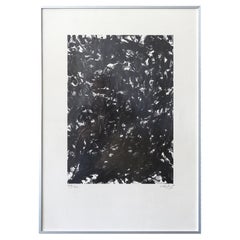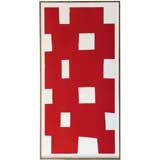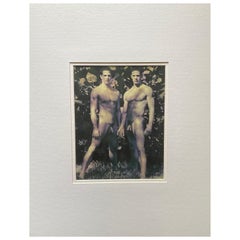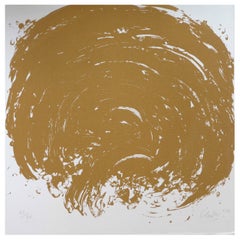Guenther Uecker Prints
German, b. 1930
Uecker was born in Wendorf, Mecklenburg. Uecker began his artistic education in 1949 when he took up studies at Wismar. He then went to the art school in Berlin-Weißensee and in 1955 to Düsseldorf, where he studied under Otto Pankok at the Kunstakademie Düsseldorf. In 1956 he began using nails in his art.
In addition to numerous Gruppo Zero exhibitions, Uecker has participated in many other exhibitions, including documenta 4, Kassel, Germany (1968), the Venice Biennale (1970), and numerous solos shows, including one at the Kunsthalle Düsseldorf (1983), a retrospective at the Kunsthalle der Hypo-Kulturstiftung, Munich (1990), and another solo show at the Ulmer Museum, Ulm, Germany (2010). He had his first solo exhibition in the United States at the Howard Wise Gallery on West 57th Street, showing important work such as the kinetic New York Dancer I (1966). He designed the scenery for Richard Wagner's Lohengrin at Bayreuth (1979–82).
Uecker met the group ZERO with Heinz Mack and Otto Piene in 1960, artists who propagated a new beginning of art in opposition to the German Informel. He occupied himself with the medium of light, studied optical phenomena, series of structures and the realms of oscillation that actively integrate the viewer and enable him to influence the visual process by kinetic or manual interference. Uecker, Mack and Piene began working together in joint studios at the Stedelijk Museum in Amsterdam in 1962 and installed a 'Salon de Lumière' at the Palais des Beaux-Arts in Paris. Other 'light salons' followed in Krefeld and in Frankfurt. Since 1966, after the group ZERO dissolved and a last joint exhibition, Uecker increasingly used nails as an artistic means of expression—a material that, until today, stands in the centre of his oeuvre. At the beginning of the 1960s he began hammering nails into pieces of furniture, musical instruments and household objects, and then he began combining nails with the theme of light, creating his series of light nails and kinetic nails and other works. a-x Zero Garden from 1966, in the collection of the Honolulu Museum of Art, demonstrates his use of nails to create the illusion of movement. Light and electricity continued to be one of the main subjects and natural materials such as sand and water were included in his installations, resulting in an interaction of the different elements to create a sensation of light, space, movement and time.
Uecker's work can be found in the collections of major institutions worldwide, among them: the ZERO foundation and Museum Kunst Palast, Düsseldorf; Calderara Foundation Collection, Milan; Courtauld Institute of Art, (London); Honolulu Museum of Art, Studio Esseci (Padua, Italy), Stedelijk Museum, Amsterdam, Van Abbemuseum (Eindhoven, Netherlands), Von der Heydt-Museum (Wuppertal, Germany); Museum of Modern Art, New York; Art Institute of Chicago, Chicago; Museum of Contemporary Art, Los Angeles; Centre Pompidou, Paris; Peggy Guggenheim Collection, Venice the Ulster Museum, Belfast; and the Walker Art Center, Minnesota.(Biography provided by Cerbera Gallery)
2
to
2
2
2
2
1
2
Height
to
Width
to
2
2
2
6
107
95
90
85
Creator: Guenther Uecker
Günther Uecker ‘Nails and Finger Marks’, 2000
By Guenther Uecker
Located in Los Angeles, CA
Wonderful limited edition, framed offset lithography on handmade paper by German sculptor, op artist and installation artist Günther Uecker (born 1930) called ‘Nails and Finger Mark...
Category
Early 2000s German Post-Modern Guenther Uecker Prints
Materials
Paper
Günther Uecker "Verletzungen, Verbindungen, " 2000
By Guenther Uecker
Located in Los Angeles, CA
Wonderful part two of a set of original screen prints on hand-made Japanese paper by German sculptor, op artist and installation artist Günther Uecker (born 1930) called "Verletzung...
Category
Early 2000s German Modern Guenther Uecker Prints
Materials
Paper
Related Items
Wall-Sized Contemporary Work by Günther Förg
By Günther Förg
Located in NYC, NY
Color woodcut on somerset satin paper, edition of 20 printed by Santa Monica Editions #1, 1990.
Dimension: 100" x 52".
Framed.
Günther Förg (born 5 Dec...
Category
Late 20th Century American Guenther Uecker Prints
Bruce Weber Print of The Carlson Twins, 2000, Hand-Toned, Matted Male Nude #2
By Bruce Weber
Located in Palm Springs, CA
We are selling 4 images of the Carlson Twins, Lane and Kyle. What we know: the series of nudes was shot by Bruce Weber in 2000. They are titled “Kyle and Lane Carlson, 2000, Bruce Weber”. All 4 images appear to be hand toned (not computer coloration). What we don’t know is if the are printed from negatives or digital prints. Purchased from a Palm Springs estate, there were a number of amazing photographs by Bruce Weber, Herb Ritts, Tony Duran...
Category
Early 2000s American Modern Guenther Uecker Prints
Materials
Paper
H 20 in W 16 in D 0.25 in
Mark Ryden Pinxit
By Mark Ryden
Located in Los Angeles, CA
Fuzzy bunnies, big-eyed girls, meat, magic and mystery.
Mark Ryden’s carnival of curiosities.
Collector’s edition: No. 51–1,050.
Limited to 1,000 individually numbered copies,...
Category
21st Century and Contemporary Italian Guenther Uecker Prints
Bruce Weber Print of The Carlson Twins, 2000, Hand-Toned, Matted Male Nude #3
By Bruce Weber
Located in Palm Springs, CA
We are selling 4 images of the Carlson Twins, Lane and Kyle. What we know: the series of nudes was shot by Bruce Weber in 2000. They are titled “Kyle and Lane Carlson, 2000, Bruce Weber”. All 4 images appear to be hand toned (not computer coloration). What we don’t know is if the are printed from negatives or digital prints. Purchased from a Palm Springs estate, there were a number of amazing photographs by Bruce Weber, Herb Ritts, Tony Duran...
Category
Early 2000s American Modern Guenther Uecker Prints
Materials
Paper
H 20 in W 16 in D 0.25 in
Bruce Weber Print of The Carlson Twins, 2000, Hand-Toned, Matted Male Nude #1
By Bruce Weber
Located in Palm Springs, CA
We are selling 4 images of the Carlson Twins, Lane and Kyle. What we know: the series of nudes was shot by Bruce Weber in 2000. They are titled “Kyle and Lane Carlson, 2000, Bruce Weber”. All 4 images appear to be hand toned (not computer coloration). What we don’t know is if the are printed from negatives or digital prints. Purchased from a Palm Springs estate, there were a number of amazing photographs by Bruce Weber, Herb Ritts, Tony Duran...
Category
Early 2000s American Modern Guenther Uecker Prints
Materials
Paper
H 16 in W 20 in D 0.25 in
Contemporary Monument Forms Abstract Art Print with Red & Blue
By Louis Jobst
Located in London, GB
Monument forms are a series of contemporary abstract paintings by Louis Jobst experimenting with form and color. These two striking black forms could be seen as an architectural monu...
Category
2010s British Modern Guenther Uecker Prints
Materials
Paper
After Raoul Dufy, Ville De Nice Galerie Des Ponchettes, 1954
Located in Holmfirth, GB
Vintage Raoul Dufy Lithographic Poster created for an exhibition at the Musee des Ponchettes, Nice. Printed by Mourlot, Paris.
Artist: (after) Raoul Dufy...
Category
1950s French Modern Vintage Guenther Uecker Prints
Materials
Paper
Mark Mahoney " Los Angeles Skull Tattoo" Giclée Print Signed 9 of 50
Located in Van Nuys, CA
Small 2015 limited to 50 print edition " Los Angeles Skull Tattoo" by Mark Mahoney Giclee print on 11" X 8 1/2" inch heavyweight watercolor paper, acid-free paper with hand-torn deckle edges. This number 9 of 50 is hand-signed and numbered by the artists and features a Día de los Muertos skull with a banner reading "Los Angeles" and features the inking style mark is known for.
Mark Mahoney is a Boston-born tattoo artist...
Category
2010s American Guenther Uecker Prints
Materials
Paper
20th Century "The Blue Heron" Print, a Copy of the Engraving by Mark Catesby
Located in Chapel Hill, NC
20th century "The Blue Heron" print, a copy of the engraving by Mark Catesby. Plate 76 from Catesby's "The Natural History of Carolina, Florida and the Bahama Islands" folio original...
Category
20th Century American Art Nouveau Guenther Uecker Prints
Materials
Glass, Wood, Paper
H 30.63 in W 24.63 in D 1 in
Contemporary Monument Forms Abstract Art Print with warm Mauve
By Louis Jobst
Located in London, GB
Monument forms are a series of contemporary abstract paintings by Louis Jobst experimenting with form and color. The warm mauve and pale red in the background depict an abstract land...
Category
2010s British Modern Guenther Uecker Prints
Materials
Acrylic, Paper
"Twilight Zink" Signed Limited Edition Giclee by Mark Kostabi
By Mark Kostabi
Located in San Diego, CA
Signed limited edition giclee on paper entitled "Twilight Zink" by Mark Kostabi circa 2020. This print is hand-signed /dated in the lower left and numbered (105/180) in the lower rig...
Category
21st Century and Contemporary American Guenther Uecker Prints
Materials
Paper
20th Century "The Crested Jay" Print, a Copy of the Engraving by Mark Catesby
Located in Chapel Hill, NC
20th century "The Crested Jay" print, a copy of the engraving by Mark Catesby. Plate 15 from Catesby's "The Natural History of Carolina, Florida and the Bahama Islands" folio origina...
Category
20th Century American Art Nouveau Guenther Uecker Prints
Materials
Glass, Wood, Paper
H 22.5 in W 37 in D 1 in
Previously Available Items
Ouroboros Series 2018 7 Large Terragraphs on Canvas
By Guenther Uecker
Located in Jesteburg, DE
Medium
Print (Sand on Canvas)
We have 7 of this series available. All Seven cost € 65.000,00 subject to availabiltiy, price for individual works is € 8.900,00
Signature
Hand-...
Category
1960s German Minimalist Vintage Guenther Uecker Prints
Materials
Paper
Günther Uecker Spiral, Original Lithograph, Signed and Numbered
By Guenther Uecker
Located in Jesteburg, DE
Günther Uecker (1930)
A beautiful original hand signed and dated lithograph on wove paper, 1965.
Condition: Very good condition.
Framed in extra thick matting and under gallery glass. The beautiful frame was hand silvered by an expert restorer.
A note on this beautiful work:
Günther Uecker was born in 1930 in Wendorf, Germany. He studied painting at the Kunsthochschule Berlin Weissensee from 1949 to 1953, and further pursued his artistic training in 1955 at the Kunstakademie Düsseldorf. Throughout the 1950s, Uecker cultivated a strong interest in repetitive practices and purification rituals, and became fascinated with the philosophies of Buddhism, Taoism, and Islam. He developed rituals of his own, including the lengthy, repetitive, meditative hammering of nails, and proceeded to translate this into his artistic practice. His nail-relief works exceed the limits of the two-dimensional plane and create a new realm for vision to explore the calculated patterns of light and shadow.
Uecker examined this effect further in the 1960s by introducing Kinetic elements into his works through the use of engines, shifting his methodology from using precise, geometric patterns to more organic and irregular arrangements. In 1961, he joined the Zero Group founded by artists Heinz Mack and Otto Piene, who advocated for a new art form a degree zero to erase the destructive, violent forces by which human experience had come to be conditioned during the war, and which were expressed in the then-prevalent Art Informel style. The Zero Group made a large impact in the European postwar milieu, influencing a number of artists with similar ideas. Central to the movement were explorations of light, technology, and an Expansion beyond traditional two-dimensional confines of the canvas, all of which are implicated in Uecker’s work.
The present work dates from this influential period.
After the dissolution of the Zero Group, Uecker's work took a turn toward body, conceptual, and Land art, and in the 1970s he designed stage sets for several operas. He taught at the Kunstakademie Düsseldorf from 1974-1995, and was promoted to professor in 1976. Uecker has been the recipient of numerous prestigious awards, such as the Staatspreis des Landes Nordrhein-Westfalen in 2015. His work has been exhibited at museums around the world, including the Stedelijk Museum, Amsterdam; the Budapest Museum of Fine Art, Budapest; the Museum of Contemporary Art, Los Angeles; the Solomon R. Guggenheim Museum, New York; Ca’ Pesaro, International Gallery of Modern Art, Venice; and the Belvedere Museum, Vienna. He has also participated in documenta, Kassel in 1964, 1968, and 1977, and the Venice Biennale in 1970. The artist’s work is included in the collections of international institutions such as the Tate Modern, London; the Museum of Modern Art, New York; Los Angeles County Museum of Art, Los Angeles; the Solomon R. Guggenheim Museum, New York; Musée national d’art moderne, Centre Georges Pompidou, Paris; the Hamburger Bahnhof, Berlin; the Peggy Guggenheim collection, Venice; and the Museum Ludwig, Cologne.
Recent exhibitions of Uecker’s work include a large-scale retrospective at K20 am Grabbeplatz, Kunstsammlung Nordrhein-Westfalen, Düsseldorf, in 2015; and a solo exhibition, Tribute to Hafez, at the Imam Ali...
Category
1960s German Minimalist Vintage Guenther Uecker Prints
Materials
Paper
Günther Uecker "Serielle Reihung" Original Nail Embossing, 1965
By Guenther Uecker
Located in Jesteburg, DE
Günther Uecker ( * 1930) "Serielle Reihung aus Abwicklung von Parallelstrukturen"
A beautiful original Hand Signed and Dated Embossing on Wove Paper, 1965.
This work is hand signed and dated by the artist "Uecker 65" at the lower right margin.
It is also numbered 23/35 from the edition of only 35 at the lower left margin.
Sheet 46,5 x 46,5 cm. Frame size 61 x 61 cm
Condition: Very good condition.
Framed in extra thick matting and under Gallery Glass. The beautiful frame was hand silvered by an expert restorer.
A Note on This beautiful work:
Günther Uecker was born in 1930 in Wendorf, Germany. He studied painting at the Kunsthochschule Berlin Weissensee from 1949 to 1953, and further pursued his artistic training in 1955 at the Kunstakademie Düsseldorf. Throughout the 1950s, Uecker cultivated a strong interest in repetitive practices and purification rituals, and became fascinated with the philosophies of Buddhism, Taoism, and Islam. He developed rituals of his own, including the lengthy, repetitive, meditative hammering of nails, and proceeded to translate this into his artistic practice. His nail-relief works exceed the limits of the two-dimensional plane and create a new realm for vision to explore the calculated patterns of light and shadow.
Uecker examined this effect further in the 1960s by introducing kinetic elements into his works through the use of engines, shifting his methodology from using precise, geometric patterns to more organic and irregular arrangements. In 1961, he joined the Zero Group founded by artists Heinz Mack and Otto Piene, who advocated for a new art form—a degree zero—to erase the destructive, violent forces by which human experience had come to be conditioned during the war, and which were expressed in the then-prevalent Art Informel style. The Zero Group made a large impact in the European postwar milieu, influencing a number of artists with similar ideas. Central to the movement were explorations of light, technology, and an expansion beyond traditional two-dimensional confines of the canvas, all of which are implicated in Uecker’s work.
The present work dates from this influential period.
After the dissolution of the Zero Group, Uecker's work took a turn toward body, Conceptual, and Land art, and in the 1970s he designed stage sets for several operas. He taught at the Kunstakademie Düsseldorf from 1974 to 1995, and was promoted to professor in 1976. Uecker has been the recipient of numerous prestigious awards, such as the Staatspreis des Landes Nordrhein-Westfalen in 2015. His work has been exhibited at museums around the world, including the Stedelijk Museum, Amsterdam; the Budapest Museum of Fine Art, Budapest; the Museum of Contemporary Art, Los Angeles; the Solomon R. Guggenheim Museum, New York; Ca’ Pesaro, International Gallery of Modern Art, Venice; and the Belvedere Museum, Vienna. He has also participated in documenta, Kassel in 1964, 1968, and 1977, and the Venice Biennale in 1970. The artist’s work is included in the collections of international institutions such as the Tate Modern, London; the Museum of Modern Art, New York; Los Angeles County Museum of Art, Los Angeles; the Solomon R. Guggenheim Museum, New York; Musée national d’art moderne, Centre Georges Pompidou, Paris; the Hamburger Bahnhof, Berlin; the Peggy Guggenheim Collection, Venice; and the Museum Ludwig, Cologne.
Recent exhibitions of Uecker’s work include a large-scale retrospective at K20 am Grabbeplatz, Kunstsammlung Nordrhein-Westfalen, Düsseldorf, in 2015; and a solo exhibition, Tribute to Hafez, at the Imam Ali...
Category
1960s German Minimalist Vintage Guenther Uecker Prints
Materials
Paper
Günther Uecker "Serielle Reihung" Original Nail Embossing, 1965
By Guenther Uecker
Located in Jesteburg, DE
Günther Uecker ( * 1930) "Serielle Reihung aus Abwicklung von Parallelstrukturen"
A beautiful original Hand Signed and Dated Embossing on Wove Paper, 1965.
This work is hand signed and dated by the artist "Uecker 65" at the lower right margin.
It is also numbered 17/35 from the edition of only 35 at the lower left margin.
Sheet 46,5 x 46,5 cm. Frame size 61 x 61 cm
Condition: Very good condition.
Framed in extra thick matting and under Gallery Glass.
A Note on This beautiful work:
Günther Uecker was born in 1930 in Wendorf, Germany. He studied painting at the Kunsthochschule Berlin Weissensee from 1949 to 1953, and further pursued his artistic training in 1955 at the Kunstakademie Düsseldorf. Throughout the 1950s, Uecker cultivated a strong interest in repetitive practices and purification rituals, and became fascinated with the philosophies of Buddhism, Taoism, and Islam. He developed rituals of his own, including the lengthy, repetitive, meditative hammering of nails, and proceeded to translate this into his artistic practice. His nail-relief works exceed the limits of the two-dimensional plane and create a new realm for vision to explore the calculated patterns of light and shadow.
Uecker examined this effect further in the 1960s by introducing kinetic elements into his works through the use of engines, shifting his methodology from using precise, geometric patterns to more organic and irregular arrangements. In 1961, he joined the Zero Group founded by artists Heinz Mack and Otto Piene, who advocated for a new art form—a degree zero—to erase the destructive, violent forces by which human experience had come to be conditioned during the war, and which were expressed in the then-prevalent Art Informel style. The Zero Group made a large impact in the European postwar milieu, influencing a number of artists with similar ideas. Central to the movement were explorations of light, technology, and an expansion beyond traditional two-dimensional confines of the canvas, all of which are implicated in Uecker’s work.
The present work dates from this influential period.
After the dissolution of the Zero Group, Uecker's work took a turn toward body, Conceptual, and Land art, and in the 1970s he designed stage sets for several operas. He taught at the Kunstakademie Düsseldorf from 1974 to 1995, and was promoted to professor in 1976. Uecker has been the recipient of numerous prestigious awards, such as the Staatspreis des Landes Nordrhein-Westfalen in 2015. His work has been exhibited at museums around the world, including the Stedelijk Museum, Amsterdam; the Budapest Museum of Fine Art, Budapest; the Museum of Contemporary Art, Los Angeles; the Solomon R. Guggenheim Museum, New York; Ca’ Pesaro, International Gallery of Modern Art, Venice; and the Belvedere Museum, Vienna. He has also participated in documenta, Kassel in 1964, 1968, and 1977, and the Venice Biennale in 1970. The artist’s work is included in the collections of international institutions such as the Tate Modern, London; the Museum of Modern Art, New York; Los Angeles County Museum of Art, Los Angeles; the Solomon R. Guggenheim Museum, New York; Musée national d’art moderne, Centre Georges Pompidou, Paris; the Hamburger Bahnhof, Berlin; the Peggy Guggenheim Collection, Venice; and the Museum Ludwig, Cologne.
Recent exhibitions of Uecker’s work include a large-scale retrospective at K20 am Grabbeplatz, Kunstsammlung Nordrhein-Westfalen, Düsseldorf, in 2015; and a solo exhibition, Tribute to Hafez, at the Imam Ali...
Category
1960s German Minimalist Vintage Guenther Uecker Prints
Materials
Paper
Guenther Uecker prints for sale on 1stDibs.
Guenther Uecker prints are available for sale on 1stDibs. These distinctive items are frequently made of paper and are designed with extraordinary care. Many of the original prints by Guenther Uecker were created in the modern style in germany during the 21st century and contemporary. Prices for Guenther Uecker prints can differ depending upon size, time period and other attributes — on 1stDibs, these items begin at $2,800 and can go as high as $2,800, while a piece like these, on average, fetch $2,800.





